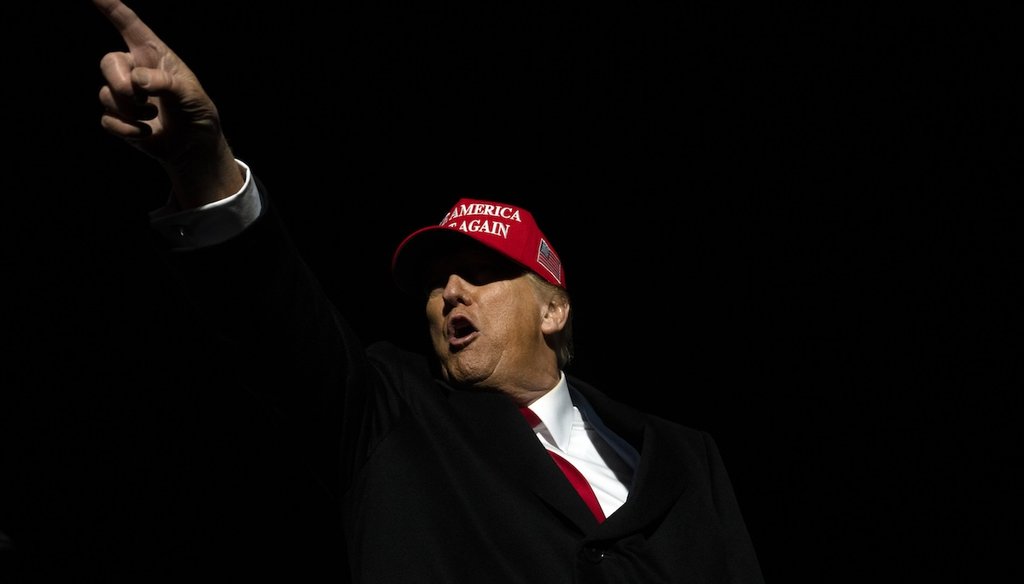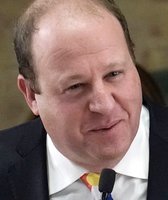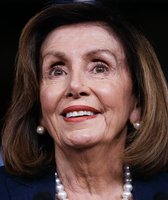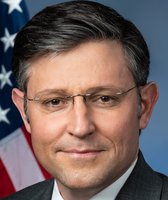Get PolitiFact in your inbox.

Former President Donald Trump at a campaign event in Schnecksville, Pa., on April 13, 2024. (AP)
Former President Donald Trump repeated a bevy of inaccurate claims on the economy during an interview with WGAL-TV, a Lancaster, Pennsylvania, television station.
Here is a rundown.
Economists have previously told PolitiFact that this is False.
The strongest evidence in favor of this assertion, at least in the U.S. context, is the unemployment rate. On Trump’s watch, the unemployment rate fell to levels untouched since the early 1950s.
However, the annual increases in gross domestic product — the sum of a country’s economic activity — were broadly similar under Trump to what they were during the final six years under his predecessor, Barack Obama. And GDP growth under Trump was well below that of previous presidents.
Wage growth also didn’t set records under Trump. Adjusted for inflation, wages began rising during the Obama years and kept increasing under Trump. But these were modest compared with the 2% a year seen in the 1960s.
Another metric — the growth rate in personal consumption per person, adjusted for inflation — wasn’t higher under Trump than previous presidents. For many families, this statistic serves an economic activity bottom line, determining how much they can spend on food, clothing, housing, health care and travel.
In Trump’s three years in office through January 2020, real consumption per person grew by 2% a year. Of the 30 nonoverlapping three-year periods from 1929 to the end of his presidency, Trump’s ranked 12th from the bottom.
Gasoline prices are higher today than they were under Trump, but most of the blame goes to factors beyond Biden’s control.
Experts say Biden’s policies may have marginal affected gasoline prices. But the price of gasoline — whether it’s high or low by historical standards — is mostly not something presidents can significantly control.
Gasoline prices initially rose on Biden’s watch because of the recovery after the worst of the pandemic. As economic activity, commuting and travel rebounded, fuel demand rose faster than global supplies did.
Then, in February 2022, Russia invaded Ukraine. NATO countries and allies sought to reduce their purchases of Russian crude oil as punishment for its war, which hampered supply. And other major oil producers, such as Saudi Arabia, have largely resisted requests to increase production to fill the void.
Overall, this has kept global crude oil prices high, even though the price has fallen since its peak in summer 2022.
Trump’s low average price was shaped by the opposite phenomenon that Biden experienced. Most of Trump’s final year in office occurred early in the pandemic, when automobile use was sharply reduced. This drove gasoline prices to unusually low levels.
Meanwhile, one factor Biden does have some control over — U.S. oil production, some of which occurs on federally leased lands — has set a record on his watch.
The first part of Trump’s talking point would have been valid in summer 2022, but that’s no longer so.
The highest U.S. inflation rates were recorded in the 1970s and early 1980s, when the annual price increase sometimes hovered between 12% and 15%. The highest rate on Biden’s watch was around 9% in summer 2022.
Since then, however, inflation has fallen. It was at 3.5% year over year in March 2024, the most recent month available.
On whether inflation is "sticking," Trump has a point.
Inflation fell consistently from its 9% peak to around 3% between June 2022 and June 2023. But since then, year-over-year inflation has bounced between about 3% and 3.5%. The Fed believes that’s still too high to start lowering interest rates, because it wants to see sustained inflation closer to 2%.
This is incorrect.
The statewide average gasoline price in California is $5.23, which is higher than it is for the nation as a whole ($3.77). But that’s well short of $7.
More to the point, not one of the 10,526 gas stations in California tracked by GasBuddy.com had gas costing $7 a gallon on the day Trump did the interview, according to data provided by GasBuddy gasoline price analyst Patrick DeHaan.
This is inaccurate.
During Trump’s entire presidency, the U.S. lost a net 2.7 million jobs. In comparison, every president since Harry Truman (who served from 1945 to 1953) has gained jobs during his tenure.
When looking at job creation patterns under a president, timing matters. For Trump. the coronavirus pandemic emerged during his fourth year in office. The resulting rapid economic contraction wiped away all the employment gains on his watch, and then some.
But even looking only at the prepandemic period, Trump’s job creation record wasn’t the best of the last five presidents, let alone all of them.
During his first three years in office, Trump oversaw a 4.6% employment increase. Two other presidents — Joe Biden and Bill Clinton — saw significantly bigger increases, of about 10% and 8%, respectively.
Both parts of this statement are wrong.
The part about the biggest tax cut is a falsehood that Trump shared repeatedly during his presidency. (Our colleagues at the Washington Post Fact Checker found that this was Trump’s second-most-commonly repeated false claim, shared 295 times during his presidency.)
In inflation-adjusted dollars, the tax bill Trump signed was the fourth-largest since 1940, and as a percentage of GDP, it ranked seventh.
Meanwhile, the part about low-income taxpayers benefiting more "is not correct," based on modeling from the Urban Institute-Brookings Institution Tax Policy Center and other think tanks, John Buhl, the Tax Policy Center’s communications director, told PolitiFact earlier this month.
The Tax Policy Center analysis found that the Trump-signed legislation would, on average, cut taxes for households in each income group, but that taxpayers in higher-income households would see the biggest benefits.
For instance, the lowest one-fifth of taxpayers — people earning up to $25,000 — would see their average federal tax rate drop by 0.4 percentage points in 2018. The drop in tax rate would be larger for each successive one-fifth of the income spectrum, with the top one-fifth seeing its tax rates drop by 1.8 percentage points. The biggest gains would go to households in the top 1% to 5% of incomes (from $307,900 to $732,000); their tax rates would drop by 3.1 percentage points.
The numbers were similar for changes through 2025, the Tax Policy Center found.
PolitiFact Senior Correspondent Amy Sherman, PolitiFact Staff Writers Samantha Putterman and Maria Ramirez Uribe and PolitiFact North Carolina Staff Writer Paul Specht contributed to this report.
Our Sources
WGAL-TV, Donald Trump discusses economy, border and the War in Israel in wide-ranging interview, Updated May 8, 2024
Email interview with Patrick DeHaan, GasBuddy gasoline price analyst, May 8, 2024
Other sources linked in article








































